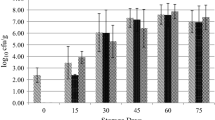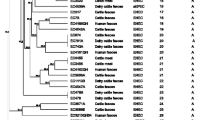Abstract
Group B Streptococcus (GBS) was previously not known to be transmitted through food, but an outbreak investigation in Singapore in 2015 documented for the first time an association between GBS Type III Sequence Type 283 infection and consumption of raw fish dishes. As very little is known about the survival of GBS during heat treatment and the stomach transit, its survival under simulated conditions was studied, in comparison with that of Escherichia coli O157:H7 and Listeria monocytogenes. The mean D-values of four GBS strains ranging from 0.72 to 0.88 min in neutral pH tryptone soy broth at 56.4 °C and 0.44–1.43 min at pH 2.35 at 37 °C in simulated gastric fluid, were significantly lower (p < 0.05) than those of E. coli O157:H7 and L. monocytogenes. This study suggests possible factors other than acid or heat resistance of GBS to be instrumental to its pathogenicity.


Similar content being viewed by others
References
Chau ML, Aung KT, Hapuarachchi HC, Lee PSV, Lim PY, Kang JSL, Ng Y, Yap HM, Yuk HG, Gutiérrez RA, Ng LC. Microbial survey of ready-to-eat salad ingredients sold at retail reveals the occurrence and the persistence of Listeria monocytogenes sequence types 2 and 87 in pre-packed smoked salmon. BMC Microbiol. 17: 46 (2017a)
Chau ML, Chen SL, Yap M, Hartantyo SH, Chiew PK, Fernandez CJ, Wong WK, Fong RK, Tan WL, Tan BZ, Ng Y, Aung KT, Mehershahi KS, Goh C, Kang JSL, Barkham T, Leong AOK, Gutiérrez RA, Ng LC. Group B Streptococcus infections caused by improper sourcing and handling of fish for raw consumption, Singapore, 2015–2016. Emerg. Infect. Dis. 23: 2002–2010 (2017b)
Delannoy CM, Crumlish M, Fontaine MC, Pollock J, Foster G, Dagleish MP, Turnbull JF, Zadoks RN. Human Streptococcus agalactiae strains in aquatic mammals and fish. BMC Microbiol. 13: 41 (2013)
Doyle ME, Mazzotta AS, Wang T, Wiseman DW, Scott VN. Heat resistance of Listeria monocytogenes. J. Food Protect. 64: 410–429 (2001)
Foster JW. Escherichia coli acid resistance: tales of an amateur acidophile. Nat. Rev. Microbiol. 2: 898–907 (2004)
Foxman B, Gillespie B, Manning S, Marrs CF. Risk factors for Group B streptococcal colonization: potential for different transmission systems by capsular type. Ann. Epidemiol. 17: 854–862 (2007)
Gandhi M, Chikindas ML. Listeria: a foodborne pathogen that knows how to survive. Int. J. Food Microbiol. 113: 1–15 (2007)
ISO. Sterilization of health care products—Requirements for validation and routine control-industrial moist heat sterilization—Industrial Moist Heat Sterilization. International Standard Organization. ISO 11134 (1994)
Kothary MH, Babu US. Infective dose of foodborne pathogens in volunteers: a review. J. Food Saf. 21: 49–68 (2001)
Le Doare K, Heath PT. An overview of global GBS epidemiology. Vaccine. 31: D7–D12 (2013)
Rajendram P, Kyaw WM, Leo YS, Ho H, Chen WK, Lin R, Pratim DP, Badaruddin H, Ang B, Barkham T, Chow A. Group B Streptococcus sequence type 283 disease linked to consumption of raw fish, Singapore. Emerg. Infect. Dis. 22: 1974–1977 (2016)
Rosini R, Margarit I. Biofilm formation by Streptococcus agalactiae: influence of environmental conditions and implicated virulence factors. Front. Cell. Infect. Microbiol. 5: 6 (2015)
Samen U, Gottschalk B, Eikmanns BJ, Reinscheid DJ. Relevance of peptide uptake systems to the physiology and virulence of Streptococcus agalactiae. J. Bacteriol. 186: 1398–1408 (2004)
Santi I, Grifantini R, Jiang SM, Brettoni C, Grandi G, Wessels MR, Soriani M. CsrRS regulates Group B Streptococcus virulence gene expression in response to environmental pH: a new perspective on vaccine development. J. Bacteriol. 191: 5387–5397 (2009)
Shabayek S, Spellerberg B. Acid stress response mechanisms of Group B Streptococci. Front. Cell. Infect. Microbiol. 7: 395 (2017)
Tan K, Wijaya L, Chiew HJ, Sitoh YY, Shafi H, Chen RC, Goh CK, Lim CC. Diffusion‐weighted MRI abnormalities in an outbreak of Streptococcus agalactiae Serotype III, multilocus sequence type 283 meningitis. J. Magn. Reson. Imaging. 45: 507–514 (2017)
Tan S, Foo K, Koh HF, Lin Y, Tow C, Zhang Y, Ang LW, Lin C, Badaruddin H, Ooi SPL, Cutter J, Heng D. Outbreak of Group B Streptococcus bacteraemia in Singapore. Epidemiol. News Bull. 42: 111–115 (2016a)
Tan S, Lin Y, Foo K, Koh HF, Tow C, Zhang Y, Ang LW, Cui L, Badaruddin H, Ooi PL, Lin RT, Cutter J. Group B Streptococcus serotype III sequence type 283 bacteremia associated with consumption of raw fish, Singapore. Emerg. Infect. Dis. 22: 1970–1973 (2016b)
Tazi A, Disson O, Bellais S, Bouaboud A, Dmytruk N, Dramsi S, Mistou MY, Khun H, Mechler C, Tardieux I, Trieu-Cuot P, Lecult M, Poyart C. The surface protein HvgA mediates Group B Streptococcus hypervirulence and meningeal tropism in neonates. J. Exp. Med. 207: 2313–2322 (2010)
Wesche AM, Gurtler JB, Marks BP, Ryser ET. Stress, sublethal injury, resuscitation, and virulence of bacterial foodborne pathogens. J. Food Prot. 72: 1121–1138 (2009)
Yang Y, Khoo WJ, Zheng Q, Chung HJ, Yuk HG. Growth temperature alters Salmonella Enteritidis heat/acid resistance, membrane lipid composition and stress/virulence related gene expression. Int. J. Food Microbiol. 172: 102–109 (2014)
Ye X, Li J, Lu M, Deng G, Jiang X, Tian Y, Quan Y, Jian Q. Identification and molecular typing of Streptococcus agalactiae isolated from pond-cultured tilapia in China. Fish. Sci. 77: 623–632 (2011)
Yuk HG, Marshall DL. Heat adaptation alters Escherichia coli O157: H7 membrane lipid composition and verotoxin production. Appl. Environ. Microb. 69: 5115–5119 (2003)
Acknowledgements
This study was jointly supported by the National University of Singapore (NUS) and the National Environment Agency (NEA), Singapore in 2017 and by the Korea National University of Transportation in 2018. We would like to thank Associate Professor Ng Lee Ching and Dr Ramona Alikiiteaga Gutiérrez of the Environmental Health Institute of the National Environment Agency for the permission on the use of GBS strains and the critical reading of the manuscript.
Author information
Authors and Affiliations
Corresponding author
Ethics declarations
Conflict of interest
The authors declare no conflict of interest.
Human and animal rights
This article does not contain any studies with human or animal subjects performed by the any of the authors.
Rights and permissions
About this article
Cite this article
Zwe, Y.H., Goh, Z.H.E., Chau, M.L. et al. Survival of an emerging foodborne pathogen: Group B Streptococcus (GBS) serotype III sequence type (ST) 283—under simulated partial cooking and gastric fluid conditions. Food Sci Biotechnol 28, 939–944 (2019). https://doi.org/10.1007/s10068-018-0525-8
Received:
Revised:
Accepted:
Published:
Issue Date:
DOI: https://doi.org/10.1007/s10068-018-0525-8




